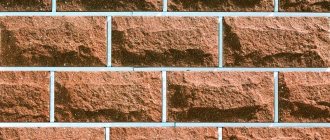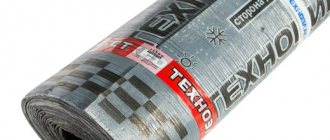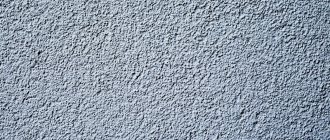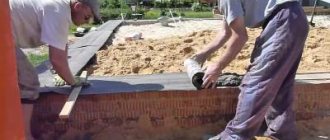Glassine is a new roofing material produced in roll form. It serves as an improved continuation of roofing felt, as it is cardboard impregnated with bitumen. Its main purpose is to retain moisture and steam from entering thermal insulation materials.
The need for vapor barriers in building structures
Vapor barrier of premises is necessary to prevent the appearance of condensation on building materials that serve as insulation for structural elements of buildings. By absorbing moisture, the insulation loses its properties and gradually deteriorates. The penetration of moisture into the heat insulator layer significantly increases its thermal conductivity, which leads to heat loss. Steam is formed inside buildings - warm air with microdroplets of water, looking for a way out of the room. These paths become the walls and ceiling of the building. Since steam generation occurs continuously, the steam gradually destroys the surfaces of building structures. The vapor barrier acts as a barrier that should protect surfaces from moisture penetration into them. Vapor barrier does not allow wooden structural elements to become damp and prevents them from rotting. When carrying out work, materials are used that have a sufficiently high resistance to moisture penetration. Based on the requirements for vapor barrier, it is clear that there is no universal vapor barrier material for all building structures of structures and buildings.
The principle of heat retention for a bath ceiling
Of course, a bathhouse is a structure with special operating conditions. Usually it is not heated, but high temperature jumps and the formation of colossal amounts of steam are regularly observed here. Because of this, the ceiling may soon become unusable. To avoid this, you can’t do without a ceiling vapor barrier a bathhouse . When it is implemented unsuccessfully, the insulation becomes wet, loses its properties, because of this, too much fuel is consumed, and it becomes uncomfortable to be in the steam room.
Requirements for vapor barrier coatings
Materials used for vapor barriers in buildings must maintain moisture resistance, low water absorption and reliably prevent moisture accumulation in structures over a long period of operation. High-quality vapor barrier meets all fire safety standards, has the necessary fire resistance and reliability. Vapor barrier coatings should not shrink - this contributes to the formation of so-called “cold bridges”. Materials for vapor barrier installations must be environmentally friendly and not emit toxic substances during operation. The thermal conductivity of coatings plays an important role: the lower its value, the less material is required for laying vapor barrier layers. Frost resistance and elasticity will ensure the safety and durability of the structures in use. A correctly selected and high-quality installed vapor barrier coating guarantees the normal moisture-technical characteristics of the building.
Glassine
Glassine is a very common type of rolled material that is used to construct a vapor barrier carpet. This material is quite inexpensive, which largely ensures its continued popularity. It is successfully used for vapor barrier, that is, protecting surfaces from the formation of condensation. Glassine is cardboard impregnated with various petroleum bitumens. After impregnation, cardboard becomes a product capable of withstanding very significant mechanical loads. The material itself has become a modern and improved continuation of roofing felt and leather, which contain large concentrations of carcinogenic tar.
Composition and manufacturing technology
To make glassine, high-density cardboard is used, impregnated with special low-melting compounds based on bitumen, which has a softening temperature of about 40 - 53 ° C. The basis for glassine is not ordinary cardboard, but a special one - roofing cardboard, with a density of 250-350 g/sq.m. To the composition of this cardboard are added crushed particles from non-woven materials, which facilitate the absorption of petroleum bitumen into the base. The cardboard itself contains about 20-40 fibrous layers of cotton, flax, wood or straw, various rag masses and similar components. To improve the technical performance of glassine, cardboard is pressed under a pressure of about 300 g/sq.m. This technology makes it possible to obtain glassine of sufficiently high strength that can withstand significant tension loads and damage to integrity.
Properties and characteristics
- High moisture resistance.
- Functions as a vapor-tight membrane.
- Effectively ventilates condensate vapors generated during operation.
- Strength. Maintains integrity for a long time.
- Heat resistance. One of the constituent components is bitumen, which has a fairly high softening point that prevents it from melting in hot weather.
- Frost resistance. Withstands extreme cold well without cracking or deteriorating strength characteristics.
- Durability. The strength characteristics of the vapor barrier ensure long-term operation.
- Excellent flexibility. Bends well at different angles without damage.
- Ease of use. The material is quite easy to process with any cutting tool. Has little weight.
Today glassine manufacturers produce 4 such brands of products: P-250; P-300; P-350; P-400. The digital value shows the brand of cardboard used in the production of glassine. A larger numerical value means improved density characteristics. Glassine marked P-400 is the densest and, accordingly, the most expensive.
The use of glassine vapor barrier coatings
This rolled material is used as a vapor barrier layer in the form of a substrate when constructing a roof. Typically, glassine is laid on top of the insulation to protect it from condensation vapor and moisture, and then the roofing coverings, be it tiles, metal profiles or slate, are installed directly. Glassine is most often used on pitched roofs due to its elasticity, lightness and effective protective properties. Glassine is used to cover wooden building structures in places of their contact with soil or concrete to prevent moisture and swelling of the wood. When materials of dissimilar composition come into contact, it acts as a vapor barrier, preventing the formation of condensation. Widely used in the construction of free-standing outdoor baths and saunas. When glassine is laid in several layers along the entire perimeter of these structures, on both sides of the heat insulator, effective vapor barrier is ensured. Glassine has also been used in the construction of multi-storey residential buildings, vapor barrier of various outbuildings (basements, garages), installation of ventilated and curtain facades.
Schemes of roofing “pies”
In this roofing “pie” scheme for a flat roof, glassine is used for vapor barrier:
- concrete floor slabs;
- double layer of glassine;
- thermal insulation layer;
- cement-sand screed;
- roofing covering.
The following scheme involves the use of material as waterproofing for a pitched roof with a cold attic:
- rafters covered with solid wood sheathing;
- double layer of glassine;
- roofing material.
In the latter scheme, glassine serves as a waterproofing and vapor barrier. This “pie” is used for gable roofs with a warm attic:
- internal lining of the attic with gypsum plasterboard sheets;
- rafter system;
- glassine vapor barrier layer on the attic side;
- thermal insulation layer;
- counter-lattice;
- glassine waterproofing layer;
- roofing covering.
From the considered diagrams we can conclude that glassine is not a roofing covering. Although, many are mistaken in these matters and use the material to cover sheds and other outbuildings. Naturally, the result of illiteracy is a leaking roof within a year.
Advantages of glassine vapor barrier
- Effective water-repellent properties due to the presence of impregnating bitumen compounds. It is characterized by acceptable water absorption - up to 15 - 20% of the total weight of the material.
- Elasticity due to high-quality impregnation of the fabric. Not subject to cracking and loss of strength at low temperatures.
- Durability. Coatings can be used for many years.
- Quite high tensile strength. It is 15 - 25 kgf.
- Significant heat resistance. Minor temperature deformation of structural elements of buildings does not damage the vapor barrier material.
- Light weight, allowing the coating to be used for roofing without reinforcing the load-bearing elements of structures.
- Versatility and ease of installation. The vapor barrier is fastened depending on the base material used - fixing with staples, using construction tape, gluing.
- Good maintainability. Replacing the vapor barrier sheet is quite easy and can be done even by non-professional workers.
- Low price.
Advantages of the material
- Availability. Insulator is sold in many hardware stores.
- Easy to install. Due to its lightness and elasticity, it does not require special skills, tools or additional labor.
- Optimal tensile strength. Able to withstand geometric and weight changes in the structure without loss of integrity.
- High adhesion. Easily adheres to any surface using bitumen mastic.
- High maintainability. Even if there is damage in the insulating layer, it can be easily patched without dismantling the entire “pie”.
Disadvantages of glassine coatings
The quality of the coating decreases when laid on a damp base. Glassine does not have an outer protective layer that protects it from the aggressive influences of the external environment: low and high temperatures, their sudden changes, precipitation, as well as from various mechanical damage. Ultraviolet rays quickly destroy glassine. Construction of the surface without subsequent covering with another roofing material is unacceptable. At low enough temperatures it breaks down. As a result, the all-season use of glassine is limited. Requires reliable natural ventilation. Moisture, condensing on glassine, leads to rotting processes in other adjacent structures. When the outside temperature increases, the material may release some harmful substances. It has limited fire resistance due to the paper base and bitumen impregnation. When using glassine, it is necessary to take into account the maintainability of the surface. The service life of glassine as a coating is limited and periodically there is a need to replace the sheets.
Are there any disadvantages?
The material cannot be used in heating conditions - at elevated temperatures it immediately begins to release volatile components and in general can emit an unpleasant odor. It certainly cannot be called environmentally friendly and completely harmless.
Important! To prevent such problems from arising and to prevent condensation from accumulating, the roof must have excellent ventilation.
The service life of glassine is no more than 5-7 years, so if you want to make a permanent roof, you will have to use more reliable materials. The coating has other disadvantages:
- cannot be installed in winter;
- cannot be mounted on wet substrates;
- not used in direct sunlight, not suitable for open surfaces.
Rules for laying rolled glassine
Before laying, it is necessary to clean the base surface in advance. Next, the glassine is rolled out, leveled, and, if necessary, a tight fit is ensured. The laid covering is trimmed along the edges of the structures and fastened. Fastening to wooden structures is done with staples. When finishing concrete products, bitumen mastic or fixation with adhesive tape is used. The next row of covering is laid with an overlap of at least 150 mm on the laid adjacent vapor barrier ball. This technique allows for high-quality overlap of strips of material. This is how all the canvases are laid. A reliable, hermetic and complete coating is achieved by thoroughly coating the seams with mastic or by additionally securing them with a mounting gun using staples. To obtain a high-quality coating, it is recommended to lay glassine in two layers. To protect and insulate the insulation, in attic rooms it is recommended to lay two layers of glassine and only after that carry out further finishing.
WE GUARANTEE HIGH QUALITY WORK
DESIGN PRESTIGE LLC was founded in 1999. The company's employees are all experienced, have Moscow registration and Slavic origin, payment is made in any convenient way, if necessary, equipment and work are provided on credit. Autonomous heating and full winter water supply.
The company's office is located near the districts: Mitino, Tushino, Strogino, Shchukino.
Nearest metro stations: Tushinskaya, Skhodnenskaya, Planernaya, Volokolamskaya, Mitino.
Nearby are the following highways: Volokolamskoe Highway, Pyatnitskoe Highway, Leningradskoe Highway.
Results and conclusions
The main disadvantages of glassine appear when it is used as coatings that are in active contact with the environment. Thus, the main area of application of this material is vapor barrier protection of insulation on structural elements of buildings and structures or as a substrate for the main roofing material. When the vapor barrier coating is glassine, the entire structure is provided with reliable protection from moisture, and its low cost deprives it of almost all competitors.











